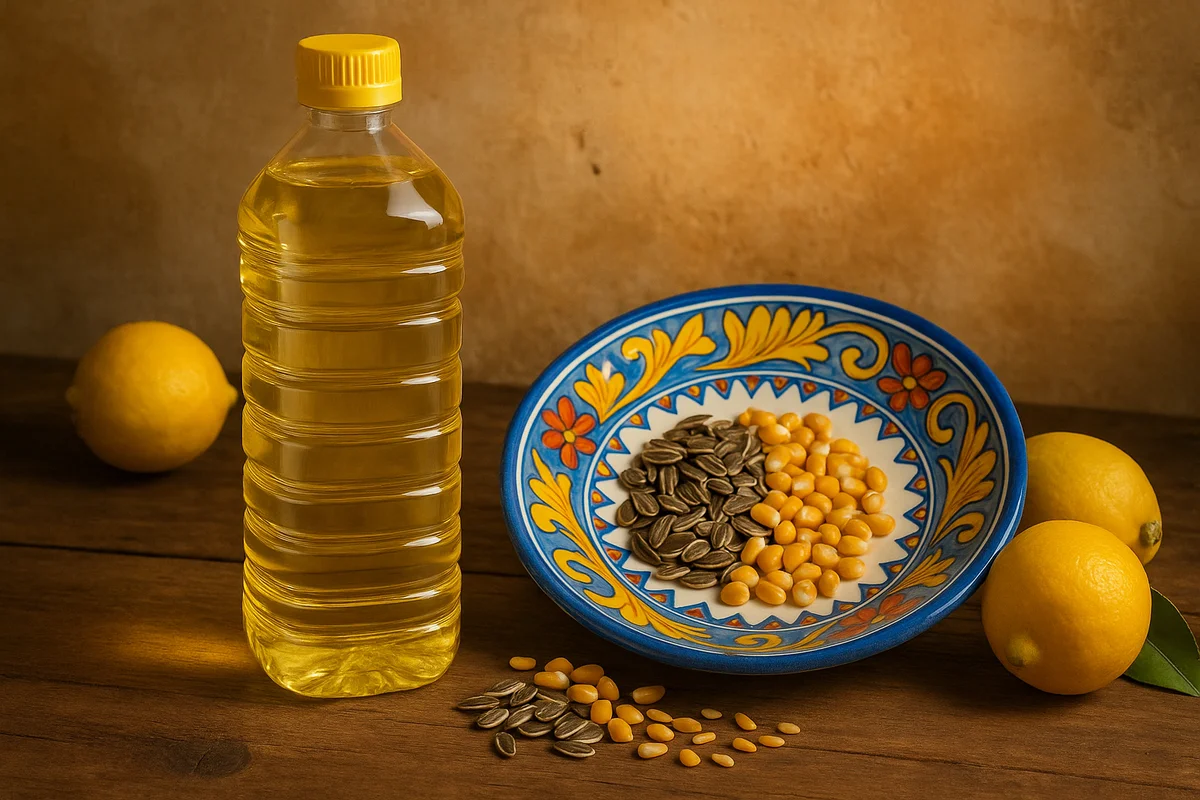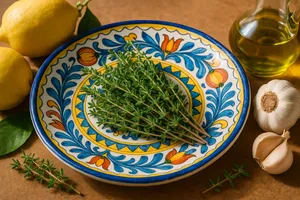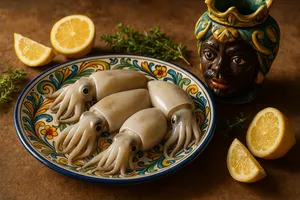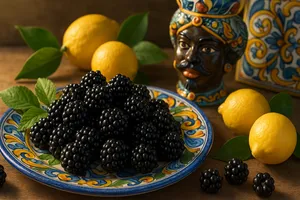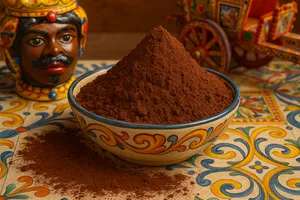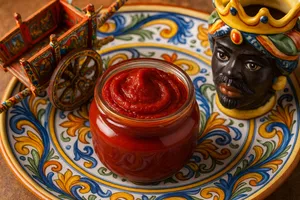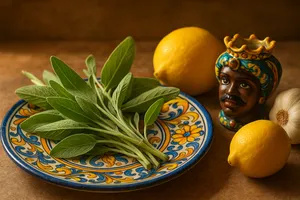Overview
Seed oil is a liquid vegetable fat obtained by pressing or chemically extracting oil-bearing seeds from various plants: sunflower, maize, peanuts, soya, rapeseed, grape seeds, and others. Unlike extra virgin olive oil, which is the traditional and principal fat of Sicilian and Mediterranean cooking, seed oil has a neutral flavour, pale colour, and characteristics that make it suited to specific culinary uses, particularly high-temperature frying where extra virgin olive oil would lose its organoleptic qualities.
In Sicily, where extra virgin olive oil reigns supreme in traditional cooking, seed oil entered common use mainly in the twentieth century as an economical alternative for particular applications. It is used chiefly for frying (arancini, panelle, assorted fritters), for sweet preparations where olive oil’s flavour would be intrusive (cakes, biscuits), and for mayonnaise and emulsified sauces where a neutral taste is preferred. Understanding the characteristics of the various seed oils, their appropriate uses, smoke points, and nutritional considerations is essential for employing them knowledgeably and safely.
Types of seed oil
Sunflower seed oil
The most common and widely used in Italy. Obtained from sunflower seeds, it has a light yellow colour, a very neutral flavour, and a medium-high smoke point (around 230°C for refined oil), ideal for frying and sweet preparations. It is rich in polyunsaturated fatty acids, particularly omega-6. It is the most versatile and appreciated seed oil for domestic use.
Peanut oil
Obtained from peanuts, it has a slightly more distinctive flavour than sunflower oil and a very high smoke point (about 230–240°C), excellent for high-temperature frying. It is rich in monounsaturated fatty acids. It costs slightly more than sunflower oil but offers excellent frying performance.
Corn oil
Extracted from the germ of maize, it has a golden colour, a slightly sweeter, more characteristic flavour, and a medium-high smoke point. It is rich in vitamin E and polyunsaturated fatty acids. It is used for frying and sweet preparations.
Soya oil
Widely used in the food industry, less so in domestic cooking. It has a neutral flavour and a medium smoke point. It is rich in polyunsaturated fatty acids, including omega-3 and omega-6. In Italy it is less common as a table oil than in other countries.
Mixed seed oil
A blend of oils obtained from various seeds (sunflower, maize, soya, rapeseed). It has very low cost, variable quality, and a neutral flavour. It is the most economical option but also the least refined in quality. Used when cost is the priority.
Grapeseed oil
Obtained from grape seeds, it has a light green colour, a delicate slightly fruity flavour, and a very high smoke point. It is rich in polyunsaturated fatty acids and vitamin E. Its cost is high and it is considered more refined. Also used raw for delicate dressings.
Rapeseed (canola) oil
Obtained from rapeseed, widely used in northern Europe and North America, less so in Italy. It has a neutral flavour, a high smoke point, and a good nutritional profile. In Italy it is often found in mixed seed oils.
Production process
Seed oils may be produced using different methods:
Cold mechanical pressing: Seeds are mechanically pressed without heating. This yields higher-quality oil with preserved nutritional properties but lower yield and higher cost. Cold-pressed oils have a more distinctive flavour and retain vitamins and antioxidants.
Refining: The most common method for industrial production. Seeds are chemically treated (often with solvents such as hexane) to extract as much oil as possible, and the crude oil is then refined through neutralisation, decolourisation, and deodorisation. The result is a neutral, clear, stable oil with high yield and low cost, though with reduced nutritional properties.
Most commercial seed oils are refined. Unrefined or cold-pressed oils are specifically labelled and have a higher price.
Culinary use
Seed oil has specific uses in cooking.
Frying
The principal use. Seed oils with high smoke points (sunflower, peanut) are ideal for frying at high temperatures (170–190°C) without degrading. In Sicily it is used to fry arancini, panelle, crocchè, fish, battered vegetables, and cartocciate. Its neutral flavour does not mask the taste of the fried food.
Sweets
In sweet preparations where extra virgin olive oil would be too assertive (cakes, loaf cakes, biscuits), seed oil lends softness without influencing flavour. It is used as an alternative to butter in lighter recipes or for those avoiding animal fats.
Mayonnaise
Mayonnaise is traditionally prepared with seed oil (preferably peanut or sunflower) to achieve a neutral and delicate sauce. Extra virgin olive oil would make the mayonnaise too strong and bitter.
Preserves in oil
Some preserves are made with seed oil to avoid the strong flavour of extra virgin olive oil overwhelming the ingredients. However, Sicilian tradition still favours extra virgin olive oil even for preserves.
Baking
For greasing tins and baking dishes, seed oil is practical and economical. It does not impart flavour to the preparations.
Seed oil vs extra virgin olive oil
The comparison helps in making informed choices:
extra virgin olive oil: A natural product obtained by mechanical pressing of olives, rich in antioxidants (polyphenols, vitamin E), monounsaturated fatty acids (beneficial to health), with a characteristic aromatic flavour, ideal for raw dressings and delicate cooking, medium smoke point (160–190°C depending on quality), higher cost, cornerstone of the Mediterranean diet with documented benefits.
Seed oil: Often a refined product obtained through chemical extraction, with reduced antioxidant and vitamin content, rich in polyunsaturated fatty acids (mainly omega-6), neutral flavour, ideal for high-temperature frying and preparations requiring neutrality, high smoke point (230–240°C for the best oils), lower cost, fulfils a functional rather than nutritional role.
From a nutritional and cultural perspective, extra virgin olive oil is superior and should remain the primary choice. Seed oil is secondary, suited to situations where it is specifically advantageous.
Smoke point
The smoke point is the temperature at which an oil begins to decompose, releasing toxic fumes and harmful substances (acrolein, aldehydes). Exceeding the smoke point renders the oil unhealthy and unpleasant in taste.
Approximate smoke points:
- Refined peanut oil: 230–240°C
- Refined sunflower oil: 225–230°C
- Refined corn oil: 230°C
- Grapeseed oil: 240°C
- Extra virgin olive oil: 160–190°C
- Olive oil (not extra virgin): 210–220°C
For professional frying (170–180°C), refined seed oils with high smoke points are ideal. High-quality extra virgin olive oil can be used for moderate-temperature frying but is not the most economical choice.
Safe frying
To fry safely with seed oil:
- Use oils with high smoke points (peanut, sunflower)
- Do not exceed 180°C; the ideal temperature is 170–175°C
- Do not reuse oil too many times (maximum 2–3 uses, filtering carefully)
- Replace oil when it becomes dark, thick, foamy, or develops an unpleasant smell
- Do not mix fresh oil with used oil
- Dispose of used oil correctly (do not pour it down the sink)
Storage
Seed oil keeps in sealed bottles in a cool, dark, dry place, away from heat sources, for 8–12 months from production. Once opened, it should be used within 3–6 months.
Seed oil is prone to oxidation, which causes rancidity. Rancid oil has an unpleasant, bitter smell and taste and must be discarded as it contains harmful substances.
Do not store oil in the refrigerator (unnecessary and may cause reversible clouding). Storage at room temperature in a sealed container is adequate.
Tips for buying
When purchasing seed oil, read the label and check:
- Specific type (sunflower, peanut, corn) rather than generic “mixed seeds”
- Expiry date: the further away, the better
- Production method: prefer “cold-pressed” if available, though more expensive
- Packaging: choose dark bottles (they protect from light) rather than clear ones
- Quality certifications if available
For frying, refined peanut or sunflower seed oil from a good brand is the optimal choice: accessible price, high smoke point, excellent performance. Avoid very cheap “mixed seed” oils, which may be of inferior quality.
Nutritional considerations
Seed oils are highly caloric: 900 kcal per 100 ml (the same as all oils and fats), composed entirely of fats. Their lipid profile varies depending on the seed of origin, but they are generally rich in polyunsaturated fatty acids, especially omega-6.
An important point: modern Western diets often contain an excess of omega-6 compared with omega-3, disrupting the ideal ratio. Heavy use of seed oils contributes to this imbalance. Omega-3s (found in fish, walnuts, flaxseed) have anti-inflammatory properties, whereas excess omega-6 can be pro-inflammatory.
Refined seed oils have lost many vitamins and antioxidants during processing, so they do not offer the nutritional benefits of extra virgin olive oil.
In a healthy diet, seed oil should be used in moderation and for specific purposes, favouring extra virgin olive oil as the main fat.
Seed oil and Sicilian tradition
In traditional Sicilian cooking, seed oil had no place. Extra virgin olive oil was used for everything: dressings, cooking, frying. Lard (pork fat) was employed for certain sweet and savoury preparations. Butter was rare, appearing only in dishes influenced by northern traditions.
Seed oil entered Sicilian households in the twentieth century, especially after the Second World War, for economic reasons (lower cost than extra virgin olive oil) and practical ones (high smoke point for frying). Today it is common in fry shops and domestic kitchens for frying and sweets, though extra virgin olive oil remains the emblematic fat of Sicilian cuisine.
Some purists of traditional cooking shun seed oil and fry even with medium-quality extra virgin olive oil (less costly than the finest grades and with an acceptable smoke point). Others consider seed oil more practical and economical for frying, reserving extra virgin olive oil for raw dressings where its qualities shine.
Curiosities
Seed oil became common only in the twentieth century. Before then, available oils were mainly olive, linseed (for industrial, not culinary use), walnut oil, and animal fats. The development of chemical extraction technologies made it possible to produce seed oils in large quantities at low cost.
During the world wars, when olive oil was scarce, seed oils became important substitutes in the Italian diet. Many people grew accustomed to their use, which continued even in peacetime for convenience.
In some countries, sunflower seed oil is considered the primary fat (Russia, Ukraine, Eastern Europe), fulfilling a role similar to that of olive oil in the Mediterranean. Culinary traditions reflect local agricultural resources.
The seed oil industry is one of the largest in the world, producing hundreds of millions of tonnes annually. Seed oils are fundamental ingredients in the food industry and appear in countless products: biscuits, snacks, sauces, margarines, baked goods.
Some seed oils also have non-food uses: linseed oil for paints and wood finishes, castor oil (not edible) for lubricants and cosmetics, rapeseed oil as biofuel.
The choice between olive oil and seed oil for frying is debated among chefs and nutritionists. Some argue that extra virgin olive oil, despite its lower smoke point, is more stable thanks to its antioxidants and therefore safer. Others prefer seed oils for their higher smoke points. The truth is that, at correct temperatures (170–175°C), both work well, but seed oil is more economical and practical for large quantities.
In Sicily, traditional fry shops preparing arancini, panelle, and sfincione often use peanut seed oil, replaced regularly, to guarantee crisp, non-greasy frying. It is a professional choice based on performance and cost.

